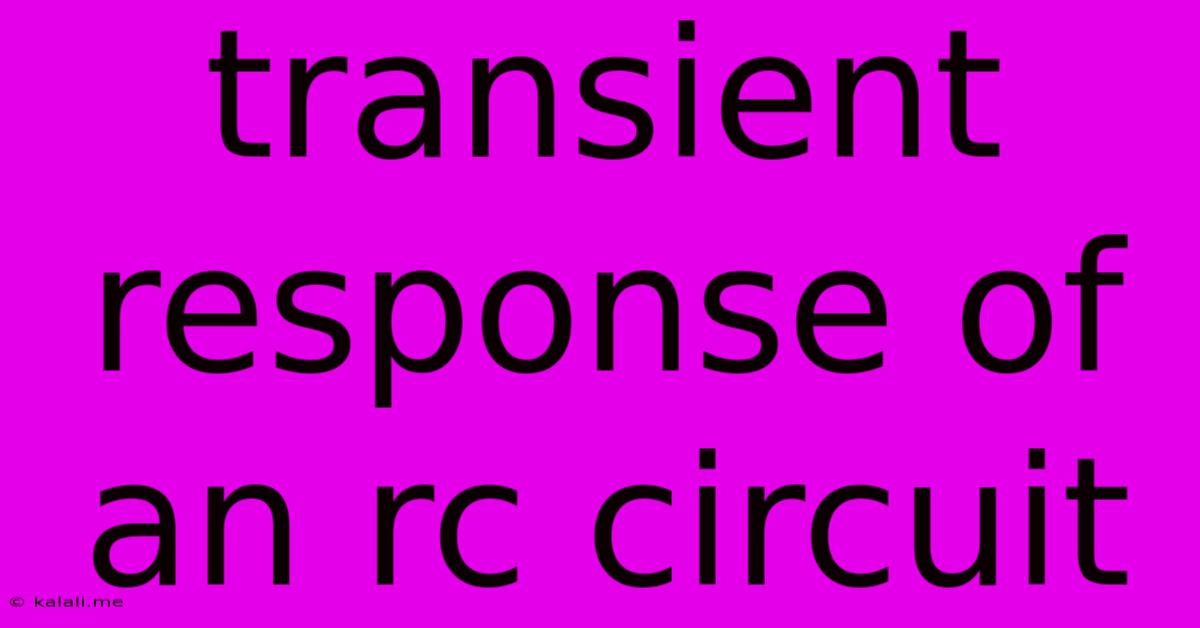Transient Response Of An Rc Circuit
Kalali
Jun 14, 2025 · 3 min read

Table of Contents
Understanding the Transient Response of an RC Circuit
The transient response of an RC circuit describes its behavior immediately following a change in the applied voltage or current. Unlike the steady-state response, which represents the circuit's behavior after all transients have decayed, the transient response captures the dynamic shift from one stable state to another. This article will explore this dynamic behavior, focusing on the charging and discharging phases of a capacitor in an RC circuit. Understanding this response is crucial for designing and analyzing various electronic systems.
What is an RC Circuit?
An RC circuit, or resistor-capacitor circuit, is a simple electrical circuit composed of a resistor (R) and a capacitor (C) connected in series or parallel. The behavior of this circuit is determined by the interaction between the resistor, which resists the flow of current, and the capacitor, which stores electrical energy in an electric field. The time constant, denoted by τ (tau), is a crucial parameter that dictates the speed of the transient response. It's calculated as the product of the resistance and capacitance: τ = RC.
Charging a Capacitor
When a DC voltage source is connected to a series RC circuit, the capacitor begins to charge. The voltage across the capacitor, Vc, doesn't jump instantaneously to the source voltage, Vs. Instead, it increases exponentially over time. This is because the resistor limits the current flow, preventing the capacitor from charging instantly. The equation governing the charging process is:
Vc(t) = Vs(1 - e^(-t/τ))
where:
- Vc(t) is the voltage across the capacitor at time t
- Vs is the source voltage
- t is the time elapsed
- τ is the time constant (RC)
- e is the base of the natural logarithm (approximately 2.718)
After one time constant (t = τ), the capacitor charges to approximately 63.2% of the source voltage. After five time constants (t = 5τ), it's considered fully charged, reaching approximately 99.3% of the source voltage. This exponential charging behavior is characteristic of first-order systems.
Discharging a Capacitor
Once the capacitor is charged, disconnecting the voltage source and connecting a path for current to flow allows the capacitor to discharge. The voltage across the capacitor now decreases exponentially, following the equation:
Vc(t) = Vs * e^(-t/τ)
Again, after one time constant (t = τ), the voltage across the capacitor decreases to approximately 36.8% of its initial value. After five time constants (t = 5τ), it's essentially fully discharged.
Time Constant and its Significance
The time constant, τ, is the most important parameter in determining the transient response speed. A smaller time constant indicates a faster charging and discharging process. Circuit designers carefully select resistor and capacitor values to achieve the desired response time based on the specific application. For instance, in a camera flash circuit, a short time constant is needed for rapid charging and discharging. Conversely, a longer time constant might be preferred in a timing circuit.
Applications of RC Circuits
RC circuits find widespread applications in various electronic systems, including:
- Timing circuits: Used in applications requiring precise timing intervals.
- Filtering circuits: Used to separate signals of different frequencies, effectively acting as low-pass or high-pass filters.
- Coupling and decoupling circuits: Used to prevent the transmission of DC signals while allowing the passage of AC signals.
- Wave shaping circuits: Used to modify the shape of waveforms.
Conclusion
Understanding the transient response of an RC circuit is essential for anyone working with electronics. By grasping the concepts of charging and discharging, the significance of the time constant, and the various applications, you can effectively design and analyze circuits for a wide range of applications. This knowledge forms a fundamental building block for more complex circuit analysis and design.
Latest Posts
Latest Posts
-
What Is The Least Common Multiple Of 12 And 14
Jun 14, 2025
-
How To Find Average Net Force
Jun 14, 2025
-
Whats The Difference Between Certified And Registered Mail
Jun 14, 2025
-
Difference Between A State And A Union Territory
Jun 14, 2025
-
What Cells In The Body Are Least Radiosensitive
Jun 14, 2025
Related Post
Thank you for visiting our website which covers about Transient Response Of An Rc Circuit . We hope the information provided has been useful to you. Feel free to contact us if you have any questions or need further assistance. See you next time and don't miss to bookmark.